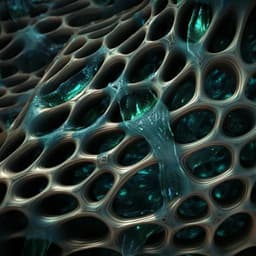
Engineering and Technology
Snail-inspired water-enhanced soft sliding suction for climbing robots
T. Yue, H. Bloomfield-gadelha, et al.
Dive into the fascinating world of robotics with research by Tianqi Yue, Hermes Bloomfield-Gadelha, and Jonathan Rossiter from the University of Bristol. This study unveils a lightweight robot inspired by snails, capable of impressive vertical and inverted sliding locomotion, utilizing water to enhance suction and reduce friction. Discover how this innovative technology could revolutionize climbing robots with high efficiency and payload management!
~3 min • Beginner • English
Introduction
The study addresses how to achieve continuous sliding locomotion with strong, safe adhesion for climbing robots using a single suction unit, inspired by snails. Conventional climbing robots maximize adhesive force but incur high friction at the contact interface, necessitating multiple pads and intermittent detachment-reattachment cycles that complicate control, add weight, reduce effective adhesion during motion, and waste energy. In contrast, snails maintain high suction while sliding via mucus that both lubricates and seals the interface. The research question is whether a liquid-mediated interface—using water as a clean, widely available mucus analogue—combined with a soft single-sucker design can simultaneously reduce friction and enhance suction to enable robust sliding suction locomotion, including on vertical and inverted surfaces, with low energy consumption and high payload capacity.
Literature Review
Prior adhesion strategies for climbing include vacuum suction, electromagnetic adhesion, gecko-inspired dry adhesion, and electro-adhesion. These typically rely on maximizing normal adhesion, which increases tangential friction and leads to discrete gaits requiring complex transmission and control, with reduced adhesion during movement. Vortex-based approaches that lift the pad to reduce contact friction suffer from severe leakage, necessitating continuous pumping, energy use, and noise; using water as the vortex medium increases force but still leaks due to the pad-substrate gap. Gel-based snail-like systems have demonstrated slope climbing but relied on stickiness rather than suction and did not show inverted adhesion. Silicone oil lubrication can improve suction on rough surfaces but risks contamination and lacked autonomous long-distance sliding in dry environments. The authors’ prior snail-inspired robot achieved sliding without adhesion. Literature on contact mechanics shows thin liquid films reduce friction and also enhance suction by sealing microgaps. These insights motivate a design that can introduce and maintain a liquid film at the suction interface without contamination, leveraging water and material modifications to self-spread liquid and enable sliding suction.
Methodology
Materials and interface design: A water self-spreading mechanism was devised using a hydrophilic silicone pad formed by incorporating poly(dimethylsiloxane-b-ethylene oxide) (PBP) into silicone. Hydrophilic pads attract water into the contact via capillarity, suppressing dry contact zones and reducing friction, while enhancing sealing for suction. Comparative flat samples with 0–2% PBP were fabricated to measure coefficient of friction (CoF) on PMMA under dry, water-wetted, and detergent-wetted conditions.
Suction cup design and tests: A soft sliding suction cup was built with a stiff polyurethane reinforcement disc (top layer) and a hydrophilic PBP-silicone bottom pad (2% PBP chosen as optimal). Geometry was optimized (50 mm diameter, 10° slope). Two variants were made: SHydPho (hydrophobic, 0% PBP) and SHydPhi (hydrophilic, 2% PBP). Sliding suction tests used a linear stage, load cell, and PMMA substrate under dry, water-immersed, and detergent-immersed conditions, recording tangential force to distinguish static (f_static) and kinetic (f_kinetic) friction. The influence of perpendicular pulling load (0, 5, 10 N via 0, 500, 1000 g masses) and substrate material (POM, PMMA, Al, with contact angles 76.8°, 68°, 57°) on f_kinetic was measured in water.
Local water environment: To operate on dry surfaces, a water secreting system delivered water locally. Four silicone microtubes fed a super-absorbing (SA) foam ring around the cup’s rim from a small pump. Capillary action in the SA foam spread water evenly, and the hydrophilic pad then drew water into the interface, achieving the same friction reduction as full submersion.
Robot design (SSR): A sliding suction robot (SSR) integrated the cup/SA foam and a pneumatic snapping chamber for autonomous attachment/detachment. The actuation unit included an air pump (to invert and release rim), a water pump (for secretion), two DC motors, and rubber wheels. Control used an ESP32 with L293D drivers; power from a 3.7 V Li-ion cell boosted to 5 V. The SSR can be tetherless via a small onboard water tank (16.7 cm³).
Operating sequence: (i) Pre-wet cup and SA foam. (ii) Air pump actuates the snapping chamber to lift the rim (inversion). (iii) User applies ~5 N contact while a small leak equilibrates; membrane snaps forward to create suction (~3 s). (iv) Water pump runs ~3 s to establish a local water seal. (v) Continuous water supply during sliding compensates losses; wheels drive rotation/translation. Detachment is by re-inverting the rim with the air pump.
Physical modeling: Force balance along the sliding plane relates tyre static friction (f_tyre) and interface kinetic friction (f_kinetic) with gravity and tilt angle α. Measurements established f_kinetic = η_wat_suc F_bend, where η_wat_suc was obtained from experiments with F_pull = 0, giving η_wat_suc = 0.29 (constant for the interface). F_bend vs F_pull was fit as F_bend = 0.12 F_pull + 1.54 N. Water loss during translation was modeled as Q_trans = V_trans d δ_film, with d = 54 mm including SA foam and δ_film ≈ 0.05 mm; rotation ideally requires Q_rot = 0.
Experimental characterization: A hinged PMMA sheet provided tilt angles 0°, 45°, 90°, 135°, 180°. The SSR executed repeated rotations (3×, 5 s each) and translations (3×, 2 s each) at constant motor voltage (5 V), recording trajectories. Loaded tests attached 1 kg mass for upside-down rotation and translation. Water film evaporation time on PMMA was monitored. Field demonstrations included untethered climbing on glass and painted metal walls, and user-controlled upside-down sliding with 200 g payload and obstacle avoidance by three naive volunteers. Fabrication and component details are provided for reproducibility (e.g., PU disc, EcoFlex 00-30 with 2% PBP, Dragon Skin 10NV for soft parts, ESP32, L293D, PWM motor/pump control).
Key Findings
- Water-enabled friction reduction and suction enhancement: Hydrophilic silicone pads (2% PBP) in water reduced CoF to ≈0.1, similar to detergent (≈0.1), and much lower than hydrophobic silicone in water (≈1.23), achieving up to 94–95% friction reduction relative to hydrophobic-water case. Increasing PBP above 2% gave little further benefit; 2% chosen as optimal.
- Sliding suction reliability in liquid: Both hydrophilic and hydrophobic cups slid when immersed; however, hydrophilic-water showed drastically lower f_kinetic and maintained suction without failure, confirming compatibility of suction and sliding and improved safety in wet conditions.
- Load and substrate effects: For SHydPhi in water, f_kinetic on PMMA increased only slightly with perpendicular pulling force, from ≈0.46 N (0 N pull) to ≈0.8 N (10 N pull). Substrate hydrophilicity inversely correlated with f_kinetic (largest on POM, smallest on Al).
- Normalized friction and mechanics: η_wat_suc = 0.29 (constant), with F_bend measured ≈1.6 N at zero pull and fitted as F_bend = 0.12 F_pull + 1.54 N. The small increase of F_bend with load indicates most of the additional pull is balanced by reduced internal pressure (no energy cost), so sliding effort increases only slightly with load.
- Water management: Translation leaves a water film of thickness δ_film ≈ 0.05 mm; Q_trans = V_trans d δ_film. Empirically, a secretion rate ≈0.05 mL/s sufficed at V_trans ≈19 mm/s. Rotation ideally requires no additional water. The residual water trail evaporated fully within 37 minutes (rapid fading in first 5 minutes), leaving no residue.
- Robot performance: The 96 g SSR achieved: average rotation speed ≈53°/s and translation speed ≈19 mm/s across tilt angles. With 1 kg payload upside-down, speeds were 23.4°/s (rotation) and 17.1 mm/s (translation). The system demonstrated stable vertical and inverted sliding, untethered climbing on glass and painted metal walls, and user-controlled obstacle avoidance upside-down with 200 g payload.
- Adhesion capacity and energy: Measured maximum stationary suction force in wet condition was 50.3 N (≈52× robot weight; ≈5.1 kg weight equivalent). Ideal modeling suggests potential payload over 460 N for an optimized design. Adhesion maintenance consumed zero power on smooth surfaces; total system maximum power ≈1.7 W with ≈1 hour theoretical runtime; 16.7 cm³ onboard water supports ≈6.19 m of sliding.
Discussion
The results demonstrate that introducing a controlled water film at a soft suction interface simultaneously reduces interfacial friction and improves sealing, enabling continuous sliding while maintaining high adhesion—analogous to snail mucus. The hydrophilic silicone pad design ensures capillary water intake and uniform wetting, while the SA foam ring and microtubes create a local wet environment on dry substrates. Empirical and modeled mechanics show that increased external load is primarily counterbalanced by a passive rise in suction (lower p_in), so sliding effort increases only slightly, which underpins the high payload capability with low extra energy. The SSR validated robust performance across orientations, including inverted operation and wall climbing on real surfaces, and practical manipulation tasks like obstacle avoidance with user control. Observed deviations (stiction patches, tyre slip) and gravity-induced wetting asymmetries explain trajectory drift and speed variations across tilt angles, but adhesion remained safe throughout. Compared with discrete pad-gait climbers, sliding suction maintains constant high adhesion during motion, reducing control and mechanical complexity and improving energy efficiency and safety.
Conclusion
This work introduces water-enhanced soft sliding suction as an adhesive locomotion strategy that unites strong suction adhesion with controllable continuous sliding. By engineering a hydrophilic silicone interface and a local water secretion system, the SSR achieves vertical and inverted sliding with low energy consumption, high adhesion efficiency, and substantial payload relative to its own mass (demonstrated 1 kg, potential higher). The approach is clean, low-cost, and leaves only a transient water film. Potential applications span industrial gripping, climbing and inspection tasks, and transportation. Future work should optimize suction cup materials and geometry to close the gap between measured and theoretical payloads, improve tyre traction and water delivery at the leading edge, integrate sensing and closed-loop control to mitigate deviation and slip, and extend capability to rougher and discontinuous surfaces, possibly with minimal pump assistance or multi-cup designs.
Limitations
Current performance requires relatively smooth surfaces; increased roughness induces leakage and higher interface friction, limiting sliding suction (though tyre static friction may improve). The system cannot traverse step-like discontinuities. Movement precision suffers from motor mismatch, transient stiction in partially wetted patches, and tyre slip when wheels become overly wetted. Practical mitigations include a small auxiliary vacuum pump to offset leakage on rough surfaces (predicted far lower energy than conventional systems), multi-cup configurations for overcoming discrete topography, repositioning water outlets toward the leading edge, applying superhydrophobic coatings to tyres to maintain grip in wet areas, and adding sensors with closed-loop control for accurate trajectory tracking.
Related Publications
Explore these studies to deepen your understanding of the subject.







